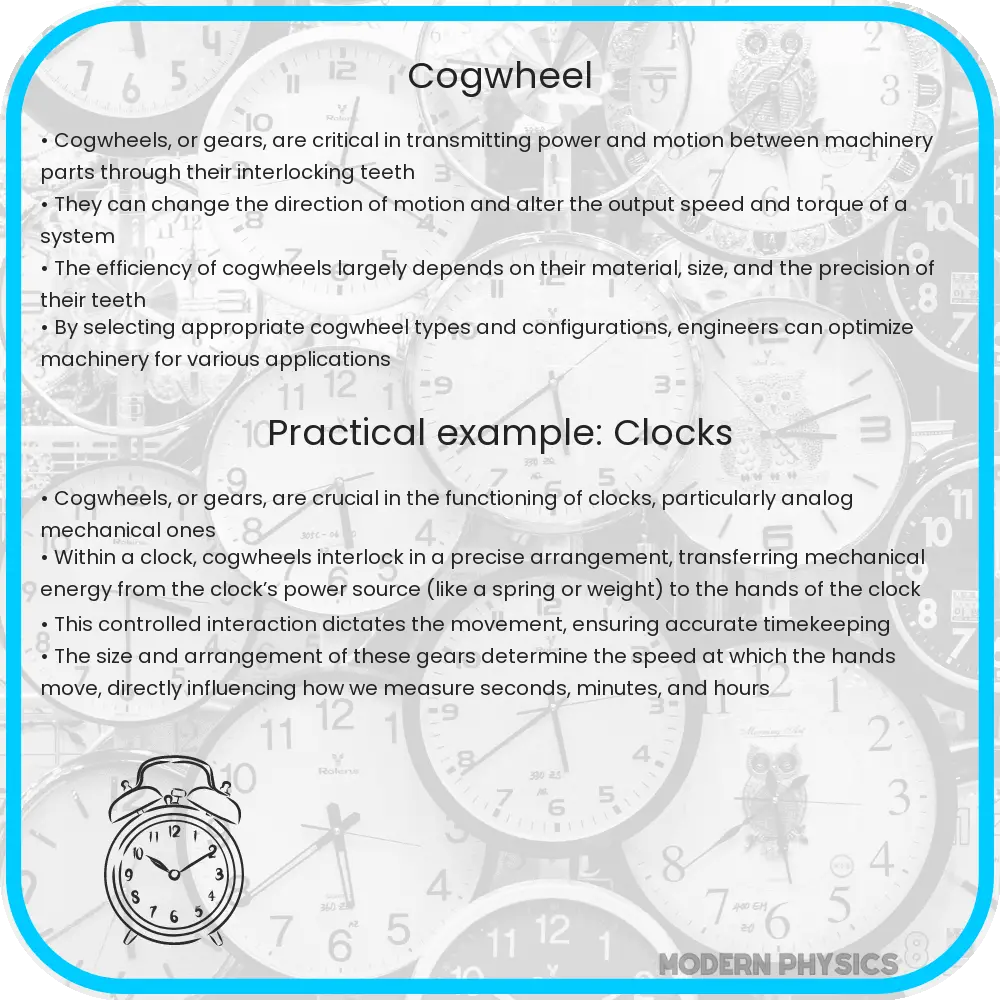Explore the essentials of cogwheel mechanics, covering load analysis, equilibrium, and torque, with insights into design, maintenance, and applications.

Understanding Cogwheel Mechanics: Load Analysis, Equilibrium, and Torque
The mechanical world operates on principles that have been fundamental to engineering and physics for centuries. Among these, cogwheel mechanics play a vital role in various machinery and devices. In this article, we delve into the intricacies of cogwheel mechanics, focusing on key aspects such as load analysis, equilibrium, and torque.
Load Analysis in Cogwheel Systems
Load analysis in cogwheels is essential for understanding the forces and stresses that these wheels endure during operation. This analysis involves calculating the load distributed over the teeth of the cogwheels. An accurate load analysis ensures that the cogwheels are designed with adequate strength and durability to handle the expected forces. This process usually involves considering the material properties, the number of teeth, and the force transmission characteristics of the cogwheel system.
Equilibrium in Cogwheel Mechanics
Equilibrium in cogwheel systems refers to the state where all the forces and moments acting on the system are balanced. This balance is crucial for the smooth and efficient functioning of the system. For a cogwheel system to be in equilibrium, the sum of all forces and the sum of all torques (or moments) must be zero. In practice, achieving equilibrium involves meticulous design and alignment of the cogwheels to ensure that the forces transmitted through the teeth are evenly distributed and do not cause excessive wear or failure.
Torque in Cogwheel Systems
Torque is a measure of the force that causes an object to rotate about an axis. In cogwheel systems, torque plays a pivotal role in determining the rotational speed and power transmission capabilities of the system. The torque transmitted through a cogwheel system depends on factors such as the size of the wheels, the number of teeth, and the force applied. Understanding and calculating torque is essential for designing cogwheel systems that meet specific speed and power requirements.
Analyzing cogwheel mechanics involves a comprehensive understanding of these three key aspects. Each element – load analysis, equilibrium, and torque – interplays to ensure the cogwheel system operates efficiently and reliably. In the next section, we will explore how these principles are applied in practical scenarios and their significance in various industrial applications.
Practical Applications of Cogwheel Mechanics
Cogwheel systems find extensive applications in various industries ranging from automotive to manufacturing. For instance, in the automotive industry, cogwheels are integral in transmissions, where they help in altering vehicle speed by transmitting torque from the engine to the wheels. In manufacturing, cogwheels are employed in machinery for precise motion control, ensuring that equipment operates smoothly and efficiently.
Advanced Considerations in Cogwheel Design
Advanced considerations in cogwheel design involve optimizing the shape and size of the teeth, selecting suitable materials, and considering environmental factors. The gear tooth profile, usually an involute curve, is designed for minimal wear and maximum efficiency. Material selection also plays a crucial role; high-strength alloys are often used for heavy-duty applications, while lighter materials might be chosen for applications where weight is a concern. Environmental factors such as temperature and humidity can also affect the performance of cogwheel systems, necessitating designs that can withstand a range of conditions.
Maintenance and Longevity of Cogwheel Systems
Maintaining cogwheel systems is vital for their longevity. Regular inspections are necessary to identify wear and tear, misalignment, or lubrication issues. Proper maintenance involves timely replacement of worn-out parts, realignment of cogwheels, and ensuring adequate lubrication to reduce friction and prevent overheating. With proper maintenance, cogwheel systems can have a significantly extended lifespan, thereby reducing downtime and repair costs.
Conclusion
The world of cogwheel mechanics is a blend of art and science. It combines the elegance of design with the robustness of engineering principles. Understanding the intricacies of load analysis, equilibrium, and torque in cogwheel systems is crucial for their effective application in various industries. As technology advances, the principles of cogwheel mechanics continue to evolve, leading to more efficient, durable, and reliable systems. Whether in the gentle turn of a watch’s hands or the powerful rotation of industrial machinery, cogwheel mechanics play an indispensable role in the smooth functioning of both simple and complex mechanical systems. The future of cogwheel mechanics looks promising, with potential advancements leading to even more innovative applications in various fields.
